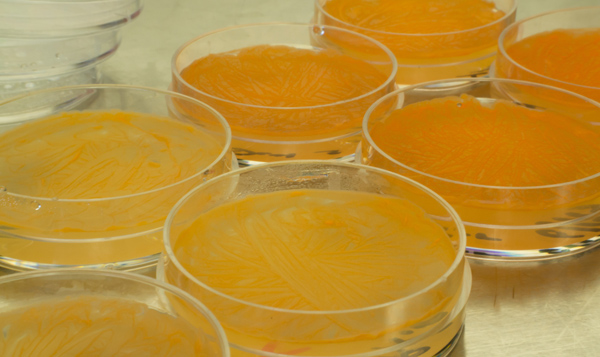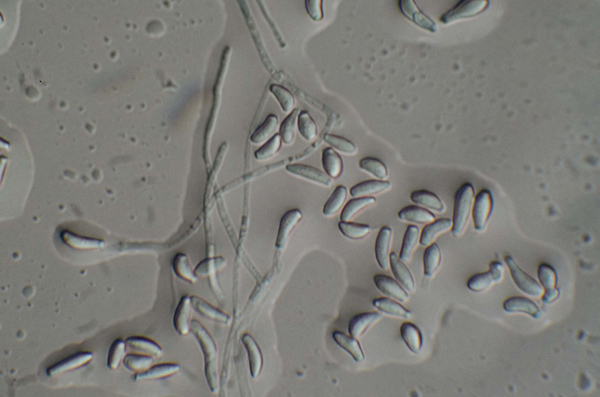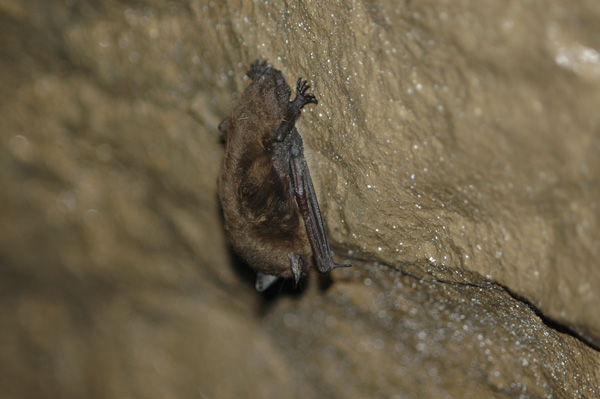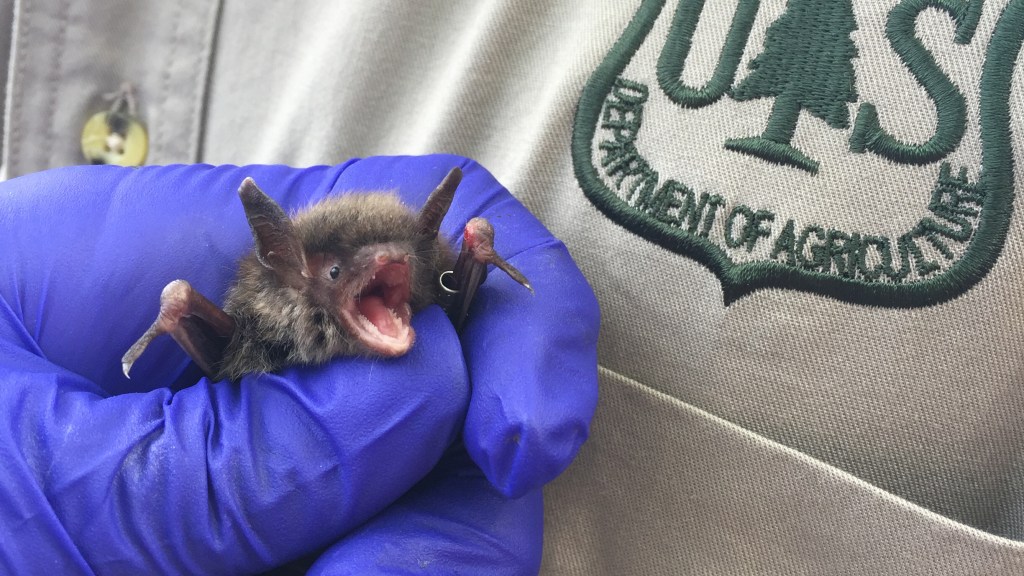Last week, 75 bats successfully treated for white-nose syndrome were released back into the wild in Missouri – rare good news in what has become one of the gloomiest wildlife stories in North America.
White-Nose Syndrome (WNS), caused by a fungus, has devastated bat populations in the eastern United States since it first appeared here almost ten years ago. An estimated 5.7 million bats have died, and conservationists have scrambled to find solutions.
The bats released last week all had White-Nose Syndrome, and were successfully treated with a common bacterium that releases Volatile Organic Compounds (VOC) with anti-fungal properties.
This hopeful story may be an important first step in managing WNS. And its scientific backstory is just as fascinating.
This innovative treatment’s development began not with bats, but with bananas.
That’s right: the bananas on your supermarket shelf play a surprising supporting role in bat conservation.

From Bananas to Bats
When researchers at Georgia State University began research on the common bacterium Rhodococcus rhodochrous they were not thinking about bats. They were not even thinking about fungi.
They were thinking about fruit. When bananas, peaches and other fruit are picked, the plants emit their own chemical signals. These begin the fruit’s ripening process.
When fruit has to be delivered thousands of miles to supermarkets – as is so often the case – it’s a race against time. The fruit can ripen and rot before it makes it to the store’s shelves.
Researchers were investigating the effectiveness of VOCs – emitted by the bacterium R. rhodochrous – in delaying ripening in fruit.

Researchers and graduate students began noticing another effect of these VOCs: fungus inhibition. The fruits exposed to the bacterium were not getting moldy.
Chris Cornelison was at the time a graduate student at Georgia State. He had been seeing the photos of dead bats piling up in caves, and a thought crossed his mind.
“I was standing there looking at a bucket of moldy bananas next to a bucket of bananas with no mold,” says Cornelison. “If the bacterium could be so effective on fungi on bananas, could it have similar effects on fungus on bats? It was one of those leaps of thought in science that maybe only a grad student could make.”
Cornelison, now a post-doctoral research associate at Georgia State, exposed petri dishes of the fungus that causes WNS (Pseudogymnoascus destructans) to the bacterium.
“The first exposure seemed too good to be true,” says Cornelison. “I had to test it five more times before I believed the results. It had dramatic effects on the fungus. It seemed like this could be a big step in managing white-nose syndrome.”
A Cooler Full of Bats
Other bat researchers and conservationists saw the potential for this bacterium and the potential to take action against a conservation issue that was frustratingly difficult to combat.
“When white-nose syndrome was first documented, we were scrambling to find information,” says Katie Gillies, director of the imperiled species program at Bat Conservation International (BCI). “We had to research the disease, understand how it works, how it spreads. But we also knew we had to take action.”
A number of partner organizations – including BCI, The Nature Conservancy and the U.S. Forest Service – worked with Georgia State researchers to test this bacterium as an initial tool to help manage WNS.
“In 2012, we tried our first crazy idea to build an artificial bat cave that could help us provide a hibernating place for bats that we could clean every year,” says Gina Hancock, state director for The Nature Conservancy in Tennessee. “Then when we formed a partnership with BCI, we kicked around what was the most promising work being done, and biocontrols came to the top of the list.”
Hancock notes that there was no public money being spent on this kind of research, so The Nature Conservancy and BCI sought proposals to accelerate the research.

At Georgia State, the laboratory results continued to be impressive. The next step was to test the bacterium on bats in a laboratory setting, and it worked. Bats suffering from WNS recovered.
Of course, the bacterium is essentially a biocontrol – a biological method of controlling an invasive species. As Cornelison notes, the use of biocontrol has a checkered history, one filled with unintended consequences.
The impacts of the bacterium on other native organisms would have to be fully vetted. But in the meantime, bats could be treated in a limited field setting.
First, bats suffering from various levels of WNS were collected in the wild. They are not actually treated with the bacterium; it’s the VOCs that have the anti-fungal properties.
The bats were placed in a mesh bags, then put in a large Yeti cooler containing plates of the bacterium. They stay there for 24 to 48 hours.
The treated bats were then placed in an enclosure in a wild cave, where they spent their hibernation. This spring, they were collected and tested for presence of WNS.
“We tested for their fungal load and compared that to the fungal load when we first captured them,” says plant pathologist Daniel Lindner, of the U.S. Forest Service’s Center for Forest Mycology Research. “The bats had no detectable signs of white-nose syndrome and could be released.”
Some of the bats had such severe wing damage from the fungus that they could not be released (these animals will serve as conservation ambassadors), but 75 were released at the Mark Twain Cave Complex in Hannibal, Missouri.
The bacterium does not cure WNS; it arrests the development of the fungus and inhibits its growth. But it is still a tremendous first step in finding ways to manage the disease.

From Lab to Cave
Could this bacterium be used to treat caves? Yes, but first more tests are needed. The treatment has to be tested for potential toxicity to other cave organisms, including native fungi. (This is why fungicides have not been used to fight WNS; they typically kill all fungi, not just the harmful species).
“We have to make sure it’s not going to upset the cave’s delicate ecology,” says Lindner.
Once those tests are completed, how do conservationists actually treat a wild cave? Researchers are considered a nebulizer that pumps the VOCs into the cave. “It’s a very sophisticated version of a commercial grade air freshener, like what a hotel might use,” says Lindner.
It could lead to treatment of caves, mines and bunkers – potentially creating safe havens for bats. “In this trial, we had to touch every single bat,” says Gillies. “The goal is to optimize this tool so that we can treat a large number of bats without touching them.”

Even then, this tool will not eliminate WNS.
“This is one tool but we will need many more to manage this disease,” says Lindner. “But tools like this could help us manage the disease. It buys time for bats to adapt to the disease and develop resistance. That could prevent extinctions and allow healthy bat populations to rebound.”
For several years, talking to bat conservationists was an exercise in despair, in helplessness. WNS is still a major problem, and one that will continue to require innovation and research on a number of fronts.
But the sight of bats – bats that would have died of the disease – flying through the woods after successful treatment suggests a new chapter in this story. A new hope. “We are finally at the point where we can intervene on white-nose syndrome,” says Gillies. “It is not a silver bullet. We need more tools. But it is a first step. A huge first step.”




Could this be a starting point to curing/controlling invasive fungi in Humans, such as toenail fungus and candida???
This was so exciting for me to read that there might be a WNS treatment. It’s been a little over a year. Any news/updates on how the treatment is working on a larger scale?
Chris Cornelison is a hero. Please convey to him our gratefulness for his insight and efforts.
Do we know where or how this fungus originated in the first place? It doesn’t do any good to get rid of the symptoms, if the source is still out there. What changed in the ecosystem to cause this eruption? Was there a chemical imbalance in caves, or in something that they were feeding on that caused them to bring the fungus back to the caves?
Great news, hope is coming back, keep it up and many congratulations
Has anyone thought to dust the bats on their egress from the caves with nystatin powder. with the possibility that they would not carry enough back to their caves in the morning to affect the resident beneficial fungi.
Cool and way to go!! Thanks to the Nature Conservancy for their assistance in exploring this option.
This is wonderful news. When I moved to the Northern Adirondacks in 1982, we had hundred of bats flying over our river at su set catching bugs on the wing. By 2005, there were no more bats on the evening. I have not seen a bat in the last 4 years. I live alone on 24 acres of wooded land with a trout stream at my front door. Plenty of room for bats to thrive. Do you think they all disappeareddue to WNS???
This is wonderful news! Thank you for sharing the results of this exciting information to help our bat populations.
This is wonderful, promising news! While caution is always the best policy, it’s thrilling to possibly see light at the end of a sad tunnel for bat populations. Here’s to good things for our struggling planet’s ecology!
Keep up the amazing work! This is such an inspiring story.
We have a large population of Bats in a cave near the Guntersville, Al. dam. The number of bats have decreased greatly over the last 2 years because of the fungus. I have always wonder why you couldn’t spray them with something when they fly out in the afternoons? The opening of the cave is like a small half moon because of the level of the Tennessee River. Doesn’t the fungus start in the layers upon layers of feces in the floor of the cave?
This article was really interesting! I’m wondering if the same substance/process could be used as an anti-fungal agent on housing in areas prone to mildew etc.
Any news in the past year on their progress?
Candice, I agree–would like to see an update/follow-up to this article, noting if there’s been any progress or what the outcome of the trial(s) have been.
Fascinating and wonderfully positive news. We have a few bats flitting about near where I live in upstate NY and I’m always wondering if they are o.k., or going to get white nose syndrome. This is an encouraging lesson in the power of observation and creativity. Yes please, go cautiously with this treatment…I love that scientists are paying attention to the whole ecology of the bat caves. Good news here tho’. How are the bananas? (could this VOC concept work on bees?)